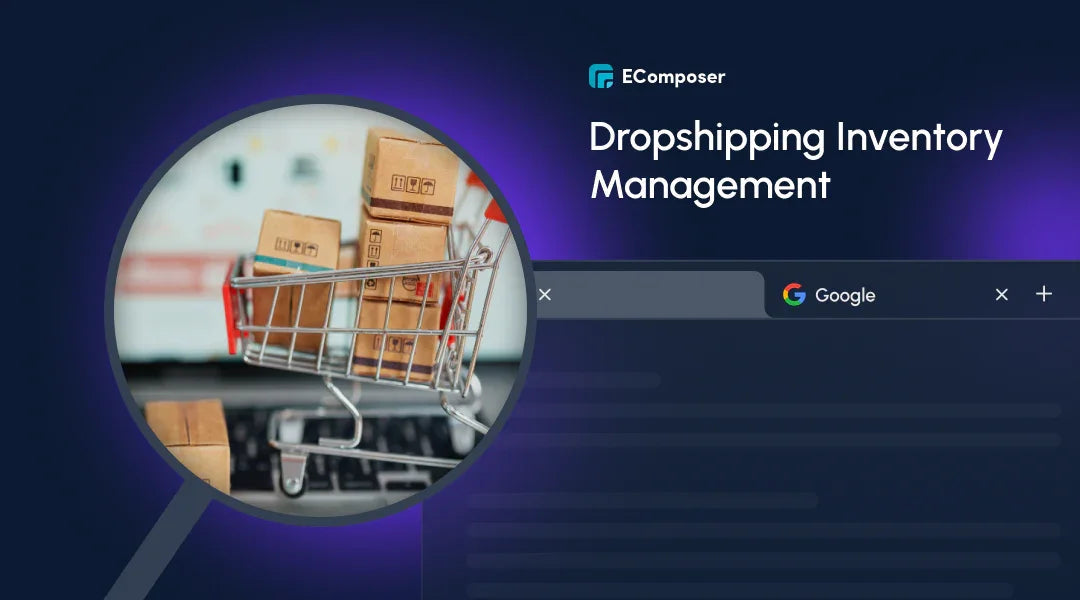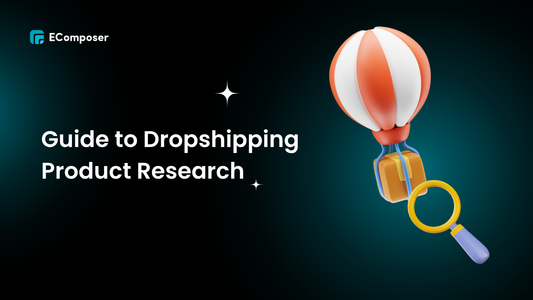Dropshipping Inventory Management: A Complete Guide for 2025

Table Of Contents
Effective inventory management in dropshipping is the backbone of any successful online store. Order fulfillment, client happiness, and your capacity to grow are all immediately impacted. Without proper control, even the most promising business can face challenges like stockouts, overstocking, and missed sales opportunities.
In this blog, we'll explore proven strategies and practical tools to help you streamline dropshipping inventory processes. Regardless of whether you're just starting out or seeking to optimize, this course will provide you the skills you need to manage inventory properly and support the growth of your business.
What is Dropshipping Inventory Management
 With the dropshipping business concept, you may sell goods without physically managing or storing them. Instead, when a customer places an order, you forward it to your third-party supplier, who ships the product directly to the customer. Inventory management in dropshipping refers to the process of ensuring the products you sell are always available for your customers without the need to hold any stock yourself.
With the dropshipping business concept, you may sell goods without physically managing or storing them. Instead, when a customer places an order, you forward it to your third-party supplier, who ships the product directly to the customer. Inventory management in dropshipping refers to the process of ensuring the products you sell are always available for your customers without the need to hold any stock yourself.
🚚 How It Works in Dropshipping:
- No physical inventory: Unlike traditional retail, you don't need to store products or worry about managing stock.
- Third-party suppliers: You partner with suppliers who handle stock and fulfillment directly.
- Real-time updates: You must rely on your suppliers for accurate, real-time inventory data to avoid selling out-of-stock products.
📈 Why Inventory Management Matters for Dropshipping Success:
- Better customer service: Efficient inventory control ensures your customers receive their orders on time without surprises.
- Fewer stockouts: Prevents selling products that aren't available, leading to more sales and less frustration.
- Increased profitability: With the right inventory system, you minimize wasted resources (like canceling orders) and maintain smooth operations that drive growth.
In order to develop your business financially and smoothly while maintaining a high level of client satisfaction, you must become proficient in dropshipping inventory management.
Common Challenges in Dropshipping Inventory Management
 1. Lack of Control Over Stock
1. Lack of Control Over Stock
One of the biggest challenges in dropshipping is not having direct control over your inventory. You depend entirely on your suppliers to manage stock, which means you're at risk of surprises.
- What happens? You might sell a product that's actually out of stock or discontinued, and the first time you find out is when the customer's order is already placed. That can leave you scrambling to make things right.
- Example: You list a trendy item in your store, but your supplier runs out of stock, and you only find out after your customer has already purchased. Now, you have to either refund the customer or delay their order, which could damage your reputation.
2. Real-Time Inventory Updates
Another crucial challenge is keeping your inventory data up to date. Without real-time sync with your supplier's system, you risk selling products that are no longer available or ordering more than you need.
- What happens? If your supplier's inventory doesn't update instantly, you might be selling a product that's already out of stock. Or worse, you could overorder and end up with products you can't move.
- Example: A customer buys an item, but when the order is forwarded to the supplier, it turns out the product was sold out last night—this leads to delays or cancellations.
3. Supplier Delays & Errors
Dropshipping means depending on your suppliers to handle the logistics, and sometimes, things don't go as planned. Delays, errors, and miscommunications can create chaos.
- What happens? Suppliers might ship your products late or send the wrong item. Without direct control, these issues are harder to fix on the fly.
- Example: You've promised a delivery date to a customer, but your supplier ships the product late. The customer reaches out, and your supplier isn't responsive enough to get the issue sorted quickly. That's an unhappy customer—and a lost sale.
4. Managing a Large Product Catalog
As your business grows and you start offering more products, managing a large product catalog becomes increasingly complex. Every supplier has different stock levels, lead times, and product variations.
- What happens? Tracking everything manually can quickly become a headache. One product might take weeks to ship, while another arrives in a few days, confusing your customers.
- Example: You might have a variety of items in your store, but some are from suppliers with long lead times, while others ship much faster. Without a proper system to manage all these moving parts, you risk confusing your customers and losing their trust if they're not kept informed about delivery expectations.
Best Dropshipping Inventory Management Strategies
For a dropshipping business to operate smoothly and successfully, inventory management is essential. When done right, it can save you time, reduce errors, and ensure customer satisfaction. Here's how you can master inventory management with smart strategies and the right tools:
1. Automate Your Inventory Management for Effortless Efficiency
 Why spend hours tracking inventory when automation can handle it for you? Tools like Shopify, Oberlo, and SparkShipping can make managing your inventory a breeze. Here's how automation works for you:
Why spend hours tracking inventory when automation can handle it for you? Tools like Shopify, Oberlo, and SparkShipping can make managing your inventory a breeze. Here's how automation works for you:
- Real-time inventory updates: Keep your stock levels accurate, preventing overselling or stockouts with automatic sync between your store and suppliers.
- Faster order fulfillment: Automated updates help suppliers fulfill orders quickly, improving customer satisfaction.
- Save time and reduce errors: You may concentrate on expanding your company because there are no more manual upgrades required.
Automation isn't just a convenience; it's a game-changer for scaling your operations smoothly.
2. Integrate with Suppliers for Seamless Stock Syncing
 Staying on top of inventory means real-time synchronization between your store and suppliers. Imagine no more headaches about whether an item is in stock. Here's how integration works its magic:
Staying on top of inventory means real-time synchronization between your store and suppliers. Imagine no more headaches about whether an item is in stock. Here's how integration works its magic:
- Instant stock updates: Your product pages automatically reflect the stock levels from your suppliers (AliExpress, Spocket, etc.), keeping you in the loop 24/7.
- Never oversell: Avoid the nightmare of accepting orders you can't fulfill—your stock is always accurate.
- Speedy fulfillment: Integrated systems allow suppliers to act fast, ensuring your customers receive their orders promptly.
When your systems are integrated, your business runs like a well-oiled machine, minimizing risk and maximizing efficiency.
3. Set Par Levels & Reorder Alerts for Smarter Inventory Control
 Prevent stockouts and keep your sales flowing by setting par levels for each product. Think of it like a safety net for your inventory:
Prevent stockouts and keep your sales flowing by setting par levels for each product. Think of it like a safety net for your inventory:
- Establish par levels: Decide the minimum quantity of each product you want to keep in stock. When it's time to reorder, you'll be alerted—no more guessing.
- Automated reorder alerts: Set alerts to notify you when your stock dips below the desired level so you can take action before it's too late.
This simple but effective strategy helps you keep popular products in stock without over-committing to inventory. Stay ahead, stay stocked!
4. Predict Demand with Data-Driven Forecasting
 Why wait for a product to sell out before you reorder? Demand forecasting helps you stay one step ahead:
Why wait for a product to sell out before you reorder? Demand forecasting helps you stay one step ahead:
- Analyze past sales data: Use historical sales information to identify trends and predict what products will be in demand in the future.
- Stay in tune with industry trends: Keep your finger on the pulse of what's hot in the market and be ready to meet demand before it peaks.
By forecasting demand, you can keep your inventory balanced—avoiding stockouts and maximizing your potential profits.
Essential Dropshipping Inventory Management Tools
Maintaining inventory control is one of the most important aspects of dropshipping that may make or ruin your company. With the right tools, you can automate the bulk of the work and scale your business seamlessly without worrying about stock outs or overstocking. Here's a curated list of game-changing tools that can elevate your inventory management and optimize your operations.
1. Shopify & Integrations: The Power of Automation
 When it comes to building a robust dropshipping store, Shopify is the platform of choice. But here's where it gets even better — when you pair it with powerful apps like Spocket, and Modalyst, managing your inventory becomes a breeze:
When it comes to building a robust dropshipping store, Shopify is the platform of choice. But here's where it gets even better — when you pair it with powerful apps like Spocket, and Modalyst, managing your inventory becomes a breeze:
- Automatic Syncing: These apps sync in real-time with suppliers, ensuring that your store's stock is always up to date. No more manually tracking products!
- Instant Product Import: Easily import trending products from top suppliers with accurate inventory levels — all it takes is a few clicks.
- Order Fulfillment Made Easy: Once your customers hit "buy," your suppliers automatically get the order details to fulfill, so you can focus on what matters most: growing your business.
With Shopify and these integrations, inventory management is automated, saving you time and preventing costly errors like overselling.
2. Advanced Inventory Tools: Take Full Control with Third-Party Software
 If you're looking to scale beyond the basics, third-party software like Katana, TradeGecko, and ShipBob are your go-to solutions for real-time tracking and managing a diverse product range across multiple platforms:
If you're looking to scale beyond the basics, third-party software like Katana, TradeGecko, and ShipBob are your go-to solutions for real-time tracking and managing a diverse product range across multiple platforms:
- Katana: A real-time inventory management system designed to sync seamlessly with your dropshipping store. Katana is perfect for businesses that need more than just a simple solution.
- TradeGecko: A multi-channel inventory management tool that allows you to track stock levels and orders across Amazon, eBay, and Etsy, so you're always in the loop, no matter where you sell.
- ShipBob: An all-in-one fulfillment platform offering warehousing and order shipping. With ShipBob, you can offload the fulfillment process while still keeping full control of your inventory.
These advanced tools ensure that no matter how complex your operations become, you have full visibility and control over your inventory levels across all channels.
3. Multi-Channel Sync: Never Lose Track of Stock Across Platforms
 Selling across multiple platforms like eBay, Amazon, Etsy, and Shopify can be a challenge — especially when it comes to keeping your stock in check. The key is multi-channel inventory syncing, and here's how you can make it work effortlessly:
Selling across multiple platforms like eBay, Amazon, Etsy, and Shopify can be a challenge — especially when it comes to keeping your stock in check. The key is multi-channel inventory syncing, and here's how you can make it work effortlessly:
- SyncSpider & Sellbrite: These platforms help you centralize your inventory across all your online stores. They automatically sync stock levels across your sales channels, ensuring that you never oversell or disappoint customers with out-of-stock products.
- Unified Dashboard: Track and manage inventory from multiple platforms all in one place, so you don't have to juggle between different websites to update stock levels.
With multi-channel syncing, you'll streamline your operations and give your customers a smooth, consistent shopping experience no matter where they buy from.
4. Low Stock Alerts: Stay Ahead with Automated Notifications
 No more scrambling at the last minute to reorder stock or dealing with frustrated customers. Setting up low stock alerts is a game-changer for dropshipping companies trying to remain competitive:
No more scrambling at the last minute to reorder stock or dealing with frustrated customers. Setting up low stock alerts is a game-changer for dropshipping companies trying to remain competitive:
- Automated Alerts: Tools like Stocky (for Shopify) and TradeGecko send you instant alerts when your inventory hits a set threshold. This ensures you never run out of your best-selling products.
- Quick Reordering: With real-time alerts, you can reorder products before they run out, keeping your stock replenished and your customers happy.
By automating low stock notifications, you ensure that you're always one step ahead, preventing stockouts and maintaining uninterrupted corporate operations.
Note: If you're using Shopify to run your online store, mastering inventory management is essential for smooth operations and growth. Discover how to streamline your inventory process with Shopify’s powerful apps, and unlock top tips and apps in this article on Shopify inventory management success.
Best Practices for Managing Dropshipping Inventory
 Successful dropshipping requires effective inventory management. You may simplify your business processes and steer clear of expensive errors by adhering to these best practices.
Successful dropshipping requires effective inventory management. You may simplify your business processes and steer clear of expensive errors by adhering to these best practices.
1. Regular Stock Audits: Stay Ahead of the Curve
Routine stock audits are a must-do to ensure your inventory data is accurate and aligns with the actual stock on hand. Regular checks prevent the possibility of overselling and keep your data up-to-date. Consider doing a monthly or quarterly audit to verify:
- Stock consistency: Compare actual stock with your supplier's data.
- Identifying discrepancies: Catching errors early saves time and money.
2. Clear Communication with Suppliers: Build Strong Partnerships
Maintaining open, clear communication with your suppliers is crucial for real-time updates on stock levels. Stay in constant contact with your suppliers to:
- Get accurate stock data: Ensure you always know what's available and when.
- Request prompt updates: Notify suppliers of any changes in order frequency or product demand.
Clear communication reduces the risk of surprises like stockouts or backorders.
3. Set Realistic Stock Expectations: Avoid Over-Promising
When you set your product listings, always set realistic stock expectations based on your supplier's lead times and stock availability. This means:
- Know your suppliers' lead times: Understand the average processing and shipping times for products.
- Communicate clearly with customers: Avoid promising quick delivery times if your supplier's processing time is longer.
Being realistic about stock availability helps you avoid disappointing customers and reduces returns.
4. Use Technology Wisely: Leverage Cloud-Based Tools
Leverage cloud-based tools and apps that can help you manage and sync inventory across multiple channels. Tools like TradeGecko, Shopify, and ShipBob offer:
- Real-time updates: Automatically sync stock across all platforms to keep your inventory levels current.
- Data-driven insights: Get comprehensive reports on sales trends and inventory needs so you can make informed decisions.
Utilizing technology enhances inventory management's overall effectiveness, lowers human error, and keeps you organized.
Mistakes to Avoid in Dropshipping Inventory Management
 Managing inventory in dropshipping can be tricky, and a few common mistakes can lead to major setbacks. Here are the key errors you need to avoid to keep your business running smoothly:
Managing inventory in dropshipping can be tricky, and a few common mistakes can lead to major setbacks. Here are the key errors you need to avoid to keep your business running smoothly:
1. Ignoring Lead Times: The Hidden Danger
One of the biggest pitfalls in dropshipping is neglecting suppliers' lead times. Failing to account for these delays can lead to stockouts, frustrated customers, and missed opportunities. Without factoring in:
- Supplier lead times: You risk selling products that aren't in stock, leading to shipping delays.
- Customer dissatisfaction: Customers don't want to wait weeks for an item—they want it now!
Always ensure you know how long your suppliers need to fulfill orders and communicate clear delivery times to your customers to manage expectations.
2. Overcomplicating the Process: Keep It Simple
While inventory management tools are important, overcomplicating the process with too many systems or unnecessary integrations can cause more harm than good. Too many moving parts can:
- Increase the chances of errors: Extra steps can lead to mismatches in stock data.
- Create confusion: A complex system may require more time than it's worth.
Stick to tools that are simple, easy to integrate, and provide the most essential data to help you stay organized without overwhelming yourself.
3. Failing to Monitor Key Metrics: Know Your Numbers
Not tracking key metrics is another costly mistake. Metrics like stock turnover rate, product performance, and supplier reliability give you vital insights into your inventory health. If you aren't monitoring these, you're:
- Missing out on optimization: You won't know which products need to be reordered or which suppliers are slowing down your process.
- Increasing the risk of stockouts or overstocking: Not having this information means you won't be able to adjust in time.
Make it a habit to regularly review your inventory reports and adjust your strategy based on the data.
4. Neglecting Returns: The Invisible Impact
Ignoring returns or not having a system in place to manage them is a recipe for disaster. When customers return products, your inventory can become skewed, leading to:
- Inaccurate stock levels: Your available stock may be inflated if returns aren't properly accounted for.
- Lost sales: If returns aren't handled efficiently, you could lose potential customers.
Be sure to track returns and exchanges to ensure they are accurately reflected in your inventory, keeping your stock levels in check and your business running smoothly.
FAQs
How do I automate my dropshipping inventory management?
Automating inventory management can save you time and reduce errors. Tools like Shopify, Oberlo, Spocket, and TradeGecko automatically sync your inventory with suppliers and update stock levels in real time. By integrating these tools with your sales platform, you can streamline inventory updates and eliminate manual tracking, keeping your store in sync with your suppliers at all times.
How can I avoid stockouts and overstocking in my dropshipping business?
To avoid stockouts and overstocking, it's essential to monitor stock levels closely and use automated alerts for low stock. Set par levels to determine minimum stock amounts and use tools like Oberlo or Katana to get real-time updates. Additionally, analyzing historical sales data and forecasting demand based on trends will assist you in keeping the proper supply and demand ratio so you never run out of in-demand items or accumulate too much inventory.
For real-time updates, how can I connect my suppliers to my inventory system?
Integrating your inventory system with suppliers for real-time updates can be done through various platforms like Shopify, Spocket, or AliExpress. These integrations automatically sync stock levels, so you always know when an item is running low or out of stock. Choose a dropshipping tool that offers seamless integration with your supplier's system to get real-time data without manual intervention.
Which inventory management strategies work well for a variety of sales channels?
Managing inventory across multiple platforms like eBay, Amazon, and Etsy requires tools that sync stock levels across all channels. Use multi-channel management software like Sellbrite or ChannelAdvisor, which integrates with your inventory system to prevent overselling. These tools centralize your inventory, ensuring accurate stock counts and making it easier to manage products across all your sales platforms.
How might inventory management for dropshipping benefit from forecasting?
Forecasting helps predict future demand by analyzing historical sales data, market trends, and seasonality. With forecasting, you can make more informed decisions about reordering products before they run out, preventing stockouts and reducing overstock. Using tools like Google Trends or Forecastly can help you forecast demand more accurately, ensuring that your inventory aligns with market needs.
Conclusion
A successful business is built on an effective inventory management system for dropshipping. You can improve operations, cut down on stockouts, and increase profitability by using automation, intelligent forecasting, and smooth supplier integration. Inventory management, when done correctly, promotes long-term profitability in addition to improving customer happiness.
Ready to take your dropshipping business to the next level? Get ahead of the competition and maximize inventory control by putting these professional tactics into practice right now!





















0 comments